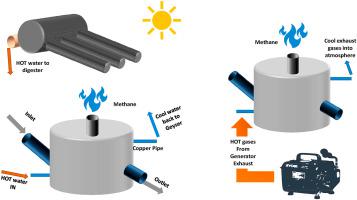Renewable and Sustainable Energy Reviews ( IF 16.3 ) Pub Date : 2020-11-07 , DOI: 10.1016/j.rser.2020.110432 Francis Makamure , Patrick Mukumba , Golden Makaka

|
This review paper studied substrate heating methods currently used in Bio-digesters with a view to assess their effectiveness in establishing and maintaining a stable temperature in a bio-digester. Stable temperature is known to enhance biogas productivity and process stability. Four heating approaches, on-vessel; floor heating; in-vessel and ex-vessel, were critically analyzed. The analysis focused on their potential to distribute heat and temperature uniformly in the whole volume of digester slurry, the ultimate effect on the methane content and quantity of the biogas produced and applicability to small scale household digesters. The study revealed that the In-vessel heating approach has the best heat and temperature distribution and that since the microbial activities responsible for methane production are sensitive to temperature fluctuations, has the highest potential to produce high quantity and quality biogas. The heating approach can also be easily applied to household biodigesters. It was also revealed that both insulation and substrate heating are necessary for digester temperature stability. The limiting factor in substrate heating in biodigesters is the heating cost. This can be minimized by using heat recovered from CHP plants and solar radiation, in case of non-electricity generating plants. Water, because of its high specific heat capacity, was recommended as a better medium of heat transfer than air in case of indirect heating. To enhance efficiency in biogas production, even household digesters should be designed with some insulation and heating facility regardless of the intended use of the produced gas.
中文翻译:

生物消化基质加热方法的分析:综述
这篇综述文章研究了目前在生物消解器中使用的底物加热方法,以评估其在生物消解器中建立和维持稳定温度的有效性。已知稳定的温度可提高沼气生产率和工艺稳定性。四种加热方式,在船上;地板采暖;严格分析了容器内和容器外。分析的重点是它们在整个消化池浆液中均匀分布热量和温度的潜力,对产生的沼气中甲烷含量和数量的最终影响以及对小型家用消化池的适用性。研究表明,容器内加热方式具有最佳的热量和温度分布,并且由于负责甲烷生产的微生物活动对温度波动敏感,具有生产大量高质量沼气的最大潜力。加热方法也可以轻松应用于家庭生物消化器。还揭示了保温器和基板加热对于蒸煮器温度稳定性都是必需的。生物消化器中底物加热的限制因素是加热成本。对于非发电厂,可以通过使用从热电联产厂回收的热量和太阳辐射来最小化。在间接加热的情况下,由于水的比热容量高,因此被推荐为比空气更好的传热介质。为了提高沼气生产效率,即使沼气池也应设计有一定的隔热和加热设施,而与沼气的预期用途无关。加热方法也可以轻松应用于家庭生物消化器。还揭示了保温器和基板加热对于蒸煮器温度稳定性都是必需的。生物消化器中底物加热的限制因素是加热成本。对于非发电厂,可以通过使用从热电联产厂回收的热量和太阳辐射来最小化。在间接加热的情况下,由于水的比热容量高,因此被推荐为比空气更好的传热介质。为了提高沼气生产效率,即使沼气池也应设计有一定的隔热和加热设施,而与沼气的预期用途无关。加热方法也可以轻松应用于家庭生物消化器。还揭示了保温器和基板加热对于蒸煮器温度稳定性都是必需的。生物消化器中底物加热的限制因素是加热成本。对于非发电厂,可以通过使用从热电联产厂回收的热量和太阳辐射来最小化。在间接加热的情况下,由于水的比热容量高,因此被推荐为比空气更好的传热介质。为了提高沼气生产效率,即使沼气池也应设计有一定的隔热和加热设施,而与沼气的预期用途无关。还揭示了保温器和基板加热对于蒸煮器温度稳定性都是必需的。生物消化器中底物加热的限制因素是加热成本。对于非发电厂,可以通过使用从热电联产厂回收的热量和太阳辐射来最小化。在间接加热的情况下,由于水的比热容量高,因此被推荐为比空气更好的传热介质。为了提高沼气生产效率,即使沼气池也应设计有一定的隔热和加热设施,而与沼气的预期用途无关。还揭示了保温器和基板加热对于蒸煮器温度稳定性都是必需的。生物消化器中底物加热的限制因素是加热成本。对于非发电厂,可以通过使用从热电联产厂回收的热量和太阳辐射来最小化。在间接加热的情况下,由于水的比热容量高,因此被推荐为比空气更好的传热介质。为了提高沼气生产效率,即使沼气池也应设计有一定的隔热和加热设施,而与沼气的预期用途无关。如果是非发电工厂。在间接加热的情况下,由于水的比热容量高,因此被推荐为比空气更好的传热介质。为了提高沼气生产效率,即使沼气池也应设计有一定的隔热和加热设施,而与沼气的预期用途无关。如果是非发电工厂。在间接加热的情况下,由于水的比热容量高,因此被推荐为比空气更好的传热介质。为了提高沼气生产效率,即使沼气池也应设计有一定的隔热和加热设施,而与沼气的预期用途无关。











































 京公网安备 11010802027423号
京公网安备 11010802027423号